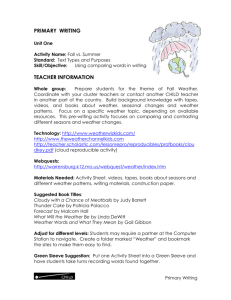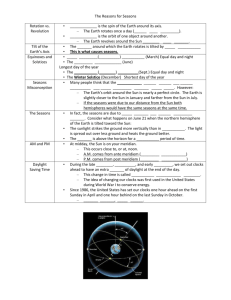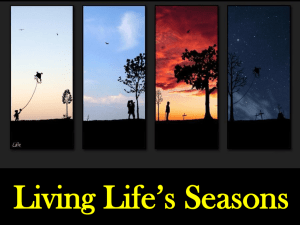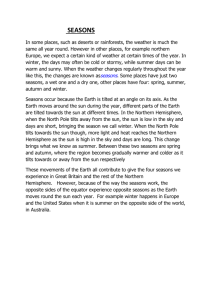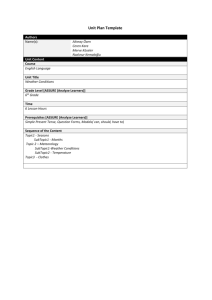Weather and Seasons Instructional Unit
advertisement
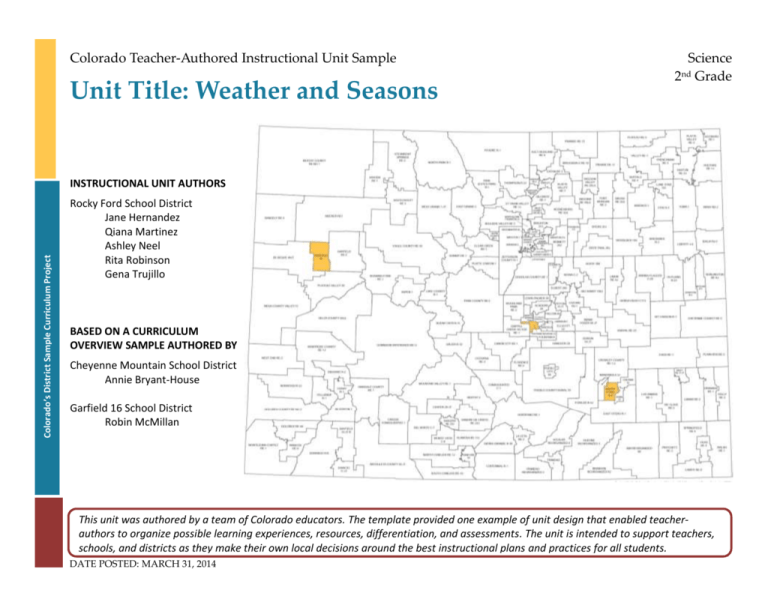
Colorado Teacher-Authored Instructional Unit Sample Science 2 Grade nd Unit Title: Weather and Seasons Colorado’s District Sample Curriculum Project INSTRUCTIONAL UNIT AUTHORS Rocky Ford School District Jane Hernandez Qiana Martinez Ashley Neel Rita Robinson Gena Trujillo BASED ON A CURRICULUM OVERVIEW SAMPLE AUTHORED BY Cheyenne Mountain School District Annie Bryant-House Garfield 16 School District Robin McMillan This unit was authored by a team of Colorado educators. The template provided one example of unit design that enabled teacherauthors to organize possible learning experiences, resources, differentiation, and assessments. The unit is intended to support teachers, schools, and districts as they make their own local decisions around the best instructional plans and practices for all students. DATE POSTED: MARCH 31, 2014 Colorado Teacher-Authored Sample Instructional Unit Content Area Science Grade Level 2nd Grade Course Name/Course Code Standard Grade Level Expectations (GLE) GLE Code 1. Physical Science 1. Changes in speed or direction of motion are caused by forces such as pushes and pulls. SC09-GR.2-S.1-GLE.1 2. Life Science 1. Organisms depend on their habitat’s nonliving parts to satisfy their needs SC09-GR.2-S.2-GLE.1 2. Each plant or animal has different structures or behaviors that serve different functions SC09-GR.2-S.2-GLE.2 1. Weather and the changing seasons impact the environment and organisms such as humans, plants, and other animals SC09-GR.2-S.3-GLE.1 3. Earth Systems Science Colorado 21st Century Skills Critical Thinking and Reasoning: Thinking Deeply, Thinking Differently Invention Information Literacy: Untangling the Web Collaboration: Working Together, Learning Together Intragrated Curriculum Design: This intradisciplinary approach matches basic elements in each of the science strands – physical, life, earth systems sciences - forming overlaps in instruction of certain topics and concepts in an authentic integrated model. Self-Direction: Own Your Learning Invention: Creating Solutions Unit Titles Length of Unit/Contact Hours Unit Number/Sequence Weather and Seasons 4-6 weeks 3 2nd Grade, Science Unit Title: Weather and Seasons Page 1 of 18 Colorado Teacher-Authored Sample Instructional Unit Unit Title Weather and Seasons Focusing Lens(es) Inf Influence Interaction Length of Unit Standards and Grade Level Expectations Addressed in this Unit 4-6 weeks SC09-GR.2-S.3-GLE.1 Inquiry Questions (EngagingDebatable): Unit Strands Earth Systems Science Concepts weather, seasons, environment, organisms, change, environment, survival, atmosphere Why would the seasons be different in different hemispheres? How do weather and changing seasons impact the behavior and/or physical characteristics of plants and animals? Generalizations My students will Understand that… Guiding Questions Factual Conceptual Organisms go through physical changes and change their behavior in order to survive the Earth’s ever-changing weather and seasons (SC09-GR.2-S.3-GLE.1-EO.a; IQ.2; RA.1,2) What changes happen to organisms and the environment from season to season? How are organisms and the environment impacted by weather or changing seasons How do weather patterns change throughout the year? (SC.09-GR.2-S.3-GLE.1; IQ.3) The changing seasons bring about different weather due to changes in the atmosphere (SC09-GR.2-S.3-GLE.1; IQ.1,3; N.1) What are the changes in weather from season to season? What are the four seasons What changes do we make in our daily lives based on changes in the weather? (SC.09-GR.2-S3-GLE.1-IQ.2) Why are there different seasons? How does the temperature change at different times during the day (morning, noon, evening) and from day to day? (SC.09-GR.2-S.3-GLE.1; IQ.1) Catastrophic events are often caused by severe weather (SC09-GR.2-S.3-GLE.1-EO.c; N.2,3) What are the different types of severe weather? How are organisms and the environment impacted by catastrophic events? 2nd Grade, Science Unit Title: Weather and Seasons Page 2 of 18 Colorado Teacher-Authored Sample Instructional Unit Critical Content: Key Skills: My students will Know… My students will be able to (Do)… The impact(s) of weather and changing seasons on organisms such as humans, plants, animals and the environment (SC09-GR.2-S.3-GLE.1-EO.a) The ways in which location and time help determine the impact of weather and seasons on organisms (SC09-GR.2-S.3-GLE.1-EO.b) Examples of how severe weather contributes to catastrophic events such as floods and forest fires (SC09-GR.2-S.3-GLE.1-EO.c) The four seasons (SC09-GR.2-S.3-GLE.1; IQ.3; N.1) Use evidence to develop a scientific explanation for how the weather and changing seasons impact the organisms such as humans, plants, animals and the environment (SC09-GR.2-S.3-GLE.1-EO.a) Analyze and interpret data such as temperatures in different locations (sun, shade) at different times and seasons as evidence as how organisms and the environment are influenced by the weather and changing seasons (SC09-GR.2-S.3-GLE.1-EO.c) Ask testable questions about weather and the seasons (SC09-GR.2-S.3-GLE.1; N.1) Make predictions, share thinking and ask others how they know that organisms in the environment are influenced by the weather and changing seasons (SC09-GR.2S.3-GLE.1; N.2) Select and use appropriate tools to measure, record and communicate data about the weather using appropriate units (SC09-GR.2-S.3-GLE.1; N.3) Critical Language: includes the Academic and Technical vocabulary, semantics, and discourse which are particular to and necessary for accessing a given discipline. EXAMPLE: A student in Language Arts can demonstrate the ability to apply and comprehend critical language through the following statement: “Mark Twain exposes the hypocrisy of slavery through the use of satire.” A student in ______________ can demonstrate the ability to apply and comprehend critical language through the following statement(s): Severe weather contributes to catastrophic events. Certain weather patterns go with specific seasons. The environment is impacted by temperature and weather. Academic Vocabulary: analyze, interpret, evidence, scientific explanation, prediction Technical Vocabulary: temperature, weather, seasons, severe, catastrophic, weather patterns, environment, organisms, impact, hemisphere 2nd Grade, Science Unit Title: Weather and Seasons Page 3 of 18 Colorado Teacher-Authored Sample Instructional Unit Unit Description: This unit focuses on the effects of weather and seasons with respect to organisms and their environment, including seasons, normal weather patterns, severe weather, and catastrophic events. Students will understand how survival is dependent upon changes in behavior and the environment. Beginning with tools to collect data on weather, across the unit students investigate weather and temperature, seasons, human and animal behavioral response to weather and seasons, and severe weather and catastrophic events. The unit culminates in a performance assessment that asks students to take the role of a weather forecaster and report on local weather within a given season. Considerations: Teachers need to consider timing of the unit based on how often science in taught during a week and the length of time for each science block. Teachers need to consider that this will be the first time students have seen these concepts, so brainstorming background vocabulary will be helpful. Unit Generalizations Key Generalization: Organisms go through physical changes and change their behavior in order to survive the Earth’s ever-changing weather and seasons Supporting Generalizations: The changing seasons bring about different weather due to changes in the atmosphere Catastrophic events are often caused by severe weather Performance Assessment: The capstone/summative assessment for this unit. Claims: (Key generalization(s) to be mastered and demonstrated through the capstone assessment.) Stimulus Material: (Engaging scenario that includes role, audience, goal/outcome and explicitly connects the key generalization) Product/Evidence: (Expected product from students) Differentiation: Organisms go through physical changes and change their behavior in order to survive the earth’s ever-changing weather and seasons. You are a Colorado weather forecaster and have been chosen to report on the effects of weather and seasons on a local environment. In your report you must include the season, the types of weather occurring within that season, the temperatures, the changes in the organisms (humans, animals, or plants) and their behavior, and the changes in the environment. You must also identify potential severe weather (e.g. hail, tornadoes, blizzards, etc.) and its effect on the local environment and organisms. Students will present their findings regarding the effects of weather and seasons on a local environment and its organisms. They must include potential severe weather (e.g. hail, tornadoes, blizzards, etc.) and its effect on the local environment and organisms. Students may use multiple modalities to demonstrate their understanding, including a written report, oral report as a forecaster, storyboard, Power Point, or a diorama with explanations. (Multiple modes for student expression) 2nd Grade, Science The teacher may incorporate accommodations/modifications of IEP such as extended time, oral presentation, use of dictionaries, etc. The teacher may allow for one-on-one presentation, not in front of whole class. The teacher may provide some of the data in advance (students must still analyze the data). The teacher may provide a writing template for the report. The teacher may allow students to create a video through voice thread. To extend this work, students may select a non-local environment and research the seasons, weather (normal and severe), and the effects on that environment and organisms (e.g. Australia, Florida, Africa, etc.). Unit Title: Weather and Seasons Page 4 of 18 Colorado Teacher-Authored Sample Instructional Unit Texts for independent reading or for class read aloud to support the content Informational/Non-Fiction Fiction Temperature – R. Olien [lexile level 670] Fuegos arrasadoes/Wildfires. – M. Doeden [lexile level 460] Inundaciones/Floods – M. Doeden [lexile level 460] Huracanes/Hurricanes – M. Schuh [lexile level 450] Tornados/Tornadoes – M. Schuh [lexile level 450] Tsunamis – M. Schuh [lexile level 450] Avalanches – M. Schuh [lexile level 450] Droughts – N. Olson Saunders-Smith, G. Winter- Saunders-Smith, G. [lexile level 425] Spring- Saunders-Smith, G. [lexile level 425] Summer- Saunders-Smith, G. [lexile level 425] Autumn- Saunders-Smith, G. [lexile level 425] Spring into Summer!/Fall into Winter! (The Cat in the Hat Knows a Lot About That Series) - Rabe, T., Ruiz, A., and Mathieu, J. [lexile level 660] The Bear Snores On – K. Wilson [lexile level 280] Bear Wants More – K. Wilson [lexile level 500] Hello, Arctic –T. Taylor [lexile level 200-250] Ongoing Discipline-Specific Learning Experiences 1. Description: 2nd Grade, Science Thinking like a scientist: Basic scientific method Teacher Resources: http://www.brainpopjr.com/science/scienceskills/scientificmethod/grownups.weml (Near middle of page teacher resources page with activities) http://undsci.berkeley.edu/teaching/misconceptions.php (A list of common misconceptions about the nature of science) http://undsci.berkeley.edu/teaching/ (Tips for introducing and teaching scientific method and experimentation) http://www.livescience.com/6727-invisible-gorilla-test-shows-notice.html (Video in which most people fail to observe large “gorilla” moving across room) http://www.shodor.org/succeed-1.0/forensic/teacher/lessons/observation.html (Lesson plan devoted to developing observation skills) http://blogs.loc.gov/teachers/2011/06/look-again-challenging-students-to-develop-closeobservation-skills/ (Library of Congress brief of tools for helping students develop observation skills) https://sites.google.com/site/mslinfieldwebquest/home (Mapped out lesson so that students become experts in Colorado weather) Student Resources: http://www.brainpopjr.com/science/scienceskills/scientificmethod/grownups.weml (At top of page student link for movie and activities about scientific method) http://www.glencoe.com/sites/common_assets/science/virtual_labs/E16/E16.html (Virtual lab to practice use of scientific method and experimentation) http://www.brainpop.com/science/scientificinquiry/scientificmethod/preview.weml (Movie and quiz for scientific method/inquiry) http://lifehacker.com/5960811/how-to-develop-sherlock-holmes+like-powers-of-observationUnit Title: Weather and Seasons Page 5 of 18 Colorado Teacher-Authored Sample Instructional Unit and-deduction (Explanation of tools to increase observation skills with hook related to Sherlock Holmes) 2. Skills: Observe, predict, and record data Assessment: The student will be assessed within learning experiences Description: Writing like a scientist: Scientific writing/writing structure Teacher Resources: http://www.sciencenotebooks.org/ (Assistance in science note booking) http://www.fossweb.com/delegate/ssi-foss-ucm/ucm?dDocName=D567879 (Science note books in K-2) http://sciencespot.net/Pages/ISNinfo.html (Presentation used at the beginning of the year to introduce ISNs to students) http://www.time4writing.com/sentence-writing/improving-sentence-structure/ (Site devoted to writing) Student Resources: http://www.sciencenotebooks.org/ (Assistance in science note booking) http://www.abcteach.com/free/p/port_26pt_line_story.pdf (Blank, lined paper with room for illustrations/visuals-great for journal entries) Assessment: The student will be assessed within learning experiences Skills: Journaling and using elementary writing structures (e.g. sentence frame and/or paragraph frames) Prior Knowledge and Experiences Students must have an understanding of habitats, the difference between hot and cold temperatures, what a thermometer is used for, basic types of weather, the four seasons, and how organisms differ. Vertical Articulation: This is the first time students will have seen these concepts. Learning Experiences # 1 – 4 Instructional Timeframe: Weeks 1-2 Learning Experience # 1 The teacher may review/assess prior knowledge checking understanding of the idea of temperature, how it relates to human behavior, and how tools (e.g., thermometer) are used to understand weather so that students can demonstrate their current level of understanding. Generalization Connection(s): 2nd Grade, Science Organisms go through physical changes and change their behavior in order to survive the Earth’s ever-changing weather and seasons The changing seasons bring about different weather due to changes in the atmosphere Unit Title: Weather and Seasons Page 6 of 18 Teacher Resources: Colorado Teacher-Authored Sample Instructional Unit http://www.sciencekids.co.nz/videos/weather.html (Short video clips showing types of weather) http://www.kidinfo.com/science/weather.html (Provides various links for all weather types and additional activities) http://www.weatherwizkids.com/weather-instruments.htm (Descriptions of various weather tools) http://worksheetgenius.com/html/thermometers.php (Blank thermometer worksheet generator) Student Resources: http://www.sciencekids.co.nz/weather.html (Site providing activities for tools) http://pbskids.org/catinthehat/games/weather-transformer.html (Interactive game demonstrating effects of weather and includes thermometer changes) Assessment: Students will demonstrate their understanding of temperature by manipulating a thermometer (e.g. paper thermometer, coloring hot and cold, etc.) and tell the teacher what types of clothes they would need to wear in different temperatures. Differentiation: (Multiple means for students to access content and multiple modes for student to express understanding.) Access (Resources and/or Process) Expression (Products and/or Performance) The teacher may provide pictures of tools and weather http://worksheetgenius.com/html/thermometers.php (blank thermometer worksheet generator) http://www.sciencekids.co.nz/videos/weather.html (short video clips showing types of weather) http://pbskids.org/catinthehat/games/weathertransformer.html (interactive game demonstrating effects of weather and includes thermometer changes) The student may draw pictures of how they would dress for different weather The student may point to pictures to demonstrate understanding Extensions for depth and complexity: Access (Resources and/or Process) Expression (Products and/or Performance) The teacher may provide other tools related to weather http://worksheetgenius.com/html/thermometers.php (blank thermometer worksheet generator) http://www.sciencekids.co.nz/weather.html (site providing activities for tools) The teacher may allow students to experiment at home with different weather tools and provide some data The student may research higher level weather tools and report back to the class about how to use these tools Critical Content: Temperature changes during the day Human behaviors change depending on temperature Key Skills: Explain temperature Critical Language: Temperature, thermometer, explain, demonstrate Learning Experience # 2 The teacher may demonstrate how to document observational data so that students can begin recording their personal observations of weather and temperatures. Generalization Connection(s): 2nd Grade, Science Organisms go through physical changes and change their behavior in order to survive the Earth’s ever-changing weather and seasons The changing seasons bring about different weather due to changes in the atmosphere Unit Title: Weather and Seasons Page 7 of 18 Teacher Resources: Colorado Teacher-Authored Sample Instructional Unit http://www.printablepaper.net/category/graph (Printable graph paper) http://homeschoolcreations.com/files/Temperatures_this_week.pdf (Printable thermometers for recording) Student Resources: http://weather.weatherbug.com/CO/Rocky%20Ford-weather.html?zcode=z6286&zip=81067 (Site providing local weather conditions – searchable for various locations) Assessment: Students will create scientific notebook entries documenting (drawing) actual weather and temperatures daily for a designated period of time and writing about the weather they have depicted (i.e., short-even one word-entries about the weather/temperature they have documented). http://www.abcteach.com/free/p/port_26pt_line_story.pdf (Blank, lined paper with room for illustrations/visuals-great for journal entries) Differentiation: (Multiple means for students to access content and multiple modes for student to express understanding.) Access (Resources and/or Process) Expression (Products and/or Performance) The teacher may allow students to color successive thermometers for the various recordings http://homeschoolcreations.com/files/Temperatures_this_we ek.pdf (Printable thermometers) The teacher may allow students to work in pairs The teacher may scaffold notebook entry pages http://www.studenthandouts.com/forms.htm (Student forms) The student may record on teacher prepared notebook entry pages Extensions for depth and complexity: Access (Resources and/or Process) Expression (Products and/or Performance) http://weather.weatherbug.com/CO/Rocky%20Fordweather.html?zcode=z6286&zip=81067 (Site providing local weather conditions – searchable for various locations) The teacher may allow students to track daily temperatures for a different location The student may report out to the class on the temperature changes in different locations Critical Content: Weather and temperature changes during the day Weather and temperature changes over a period of time. Key Skills: Record observations based on reading of the thermometer Critical Language: Temperature, thermometer, observations, record, weather, record, create, observe Learning Experience # 3 The teacher may provide opportunities to research past weather temperatures for a given location so that students can look for patterns in weather and temperatures across seasons. Generalization Connection(s): 2nd Grade, Science Organisms go through physical changes and change their behavior in order to survive the Earth’s ever-changing weather and seasons The changing seasons bring about different weather due to changes in the atmosphere Unit Title: Weather and Seasons Page 8 of 18 Colorado Teacher-Authored Sample Instructional Unit Teacher Resources: http://weather.org/weatherorg_records_and_averages.html (Shows map of the world and can hyperlink to a certain location for weather) www.almanac.com/weather/history (Almanac) On the Same Day in March: a tour of the world’s weather – M. Singer [lexile level AD540L] http://www.weather.com/video/nature-changing-around-us-35904 (Video showing changes in weather in various locations) Student Resources: http://weather.org/weatherorg_records_and_averages.html (Shows map of the world and can hyperlink to a certain location for weather) http://www.weather.com/video/nature-changing-around-us-35904 (Video showing changes in weather in various locations) Assessment: Students will produce a record of past temperatures for their local community for the previous month (e.g., science notebook addition, computer print-outs, etc.). Differentiation: (Multiple means for students to access content and multiple modes for student to express understanding.) Access (Resources and/or Process) Expression (Products and/or Performance) The teacher may provide multiple sources for retrieving data (e.g. National weather service, National center for atmospheric research, etc.) The teacher may allow students to work in pairs The student may color successive thermometers for the various recordings or orally discuss these with the teacher http://homeschoolcreations.com/files/Temperatures_this_week.pd f (Printable thermometers) Extensions for depth and complexity: Access (Resources and/or Process) Expression (Products and/or Performance) http://weather.org/weatherorg_records_and_averages.html (Site providing past weather conditions – searchable for various locations) The student may track past temperatures in a different location Critical Content: Temperature changes over a period of time Key Skills: Researching and recording past temperatures in identified location Critical Language: Temperature, thermometer, observations, record, research, weather, research, identify Learning Experience # 4 The teacher may direct students in the creation of graphs from selected temperature data so the students can begin exploring how to visually represent, interpret, and make predictions based on (temperature) data. Generalization Connection(s): The changing seasons bring about different weather due to changes in the atmosphere Teacher Resources: http://www.printablepaper.net/category/graph (Printable graph paper) http://www.weatherwizkids.com/index.htm (Weather forecasting) http://www.gobookee.org/temperature-graph-for-kids/ (Assists in creation of graphing collected temperature data) http://nces.ed.gov/nceskids/createagraph/default.aspx (Online way to create different types of graphs) Student Resources: http://www.weatherwizkids.com/index.htm (Weather forecasting) 2nd Grade, Science Unit Title: Weather and Seasons Page 9 of 18 Colorado Teacher-Authored Sample Instructional Unit Assessment: Students will create and interpret their graph by identifying patterns and make predictions (e.g. presenting findings to their peers via oral presentation, written communication, etc.) Differentiation: (Multiple means for students to access content and multiple modes for student to express understanding.) Access (Resources and/or Process) Expression (Products and/or Performance) The teacher may provide graphing template The teacher may allow students to work in pairs The student may demonstrate their understanding of patterns one on one with teacher The student may verbally answer question prompts to demonstrate knowledge Extensions for depth and complexity: Access (Resources and/or Process) Expression (Products and/or Performance) N/A The student may graph and compare local weather findings to another location using the same periods Critical Content: Temperature changes over time Interpreting data Making predictions based on data Compare predictions to actual results Key Skills: Creating various forms of graphs Graphing temperature changes for an extended period of time Interpreting data Making predictions based on data Critical Language: Temperature, data, bar graph, line graph, interpret, predict, compare, create, graph Learning Experiences # 5 – 6 Instructional Timeframe: Week 3 Learning Experience # 5 The teacher may provide different visual examples of weather so that students can begin identifying the relationship between different kinds of weather and seasons. Generalization Connection(s): Organisms go through physical changes and change their behavior in order to survive the Earth’s ever-changing weather and seasons The changing seasons bring about different weather due to changes in the atmosphere Catastrophic events are often caused by severe weather Teacher Resources: Winter- Saunders-Smith, G. [lexile level 425] Spring- Saunders-Smith, G. [lexile level 425] Summer- Saunders-Smith, G. [lexile level 425] Autumn- Saunders-Smith, G. [lexile level 425] 2nd Grade, Science Unit Title: Weather and Seasons Page 10 of 18 Colorado Teacher-Authored Sample Instructional Unit http://www.youtube.com/watch?v=lmIFXIXQQ_E&safety_mode=true (Short video clip showing all 4 seasons) http://www.youtube.com/watch?v=hFMrztbRXEU&safety_mode=true (Short video clip showing weather during the season changes) http://www.softschools.com/math/venn_diagram/venn_diagram_maker/ (Venn diagram worksheet generator) Student Resources: http://pbskids.org/catinthehat/games/weather-transformer.html (Interactive game demonstrating effects of weather and includes thermometer changes) http://www.youtube.com/watch?v=lmIFXIXQQ_E&safety_mode=true (Short video clip showing all 4 seasons) http://www.youtube.com/watch?v=hFMrztbRXEU&safety_mode=true (Short video clip showing weather during the season changes) http://www.classtools.net/education-games-php/venn_intro (Interactive venn diagram can be printed) Assessment: Students will demonstrate their understanding of the relationship of seasons and weather by producing an exit ticket where they compare and contrast different types of weather. http://www.teacherspayteachers.com/Product/Blackline-Chevron-Exit-Slips-Freebie-358084 (Elementary exit tickets) Differentiation: (Multiple means for students to access content and multiple modes for student to express understanding.) Access (Resources and/or Process) Expression (Products and/or Performance) http://pbskids.org/catinthehat/games/weather-transformer.html (Interactive game demonstrating effects of weather and includes thermometer changes) http://www.classtools.net/education-games-php/venn_intro (Interactive Venn diagram can be printed) The student may match pictures of weather and seasons or pointing to appropriate relationship The student may draw a picture of the relationship between weather and seasons Extensions for depth and complexity: Access (Resources and/or Process) Expression (Products and/or Performance) The teacher may provide other locations to be used for comparison to local weather and seasons http://www.timeanddate.com/weather/?sort=6 (Site shows temperatures for same time periods all over the world) http://www.educationworld.com/tools_templates/EW_venndiagram_4.doc (Venn document) The student may produce a Venn diagram showing their findings from other locations Critical Content: Seasons Weather and temperature relationships Key Skills: Explain changes in seasons Compare and contrast weather in each season Explain relationships between seasons and weather Critical Language: Seasons (winter, spring, summer, fall), weather (snow, rain, heat, wind, etc.), relationship, explain, compare, contrast 2nd Grade, Science Unit Title: Weather and Seasons Page 11 of 18 Colorado Teacher-Authored Sample Instructional Unit Learning Experience # 6 The teacher may brainstorm with students the changes humans make related to season and weather to guide students’ thinking about how the changing weather affects them. Generalization Connection(s): Organisms go through physical changes and change their behavior in order to survive the Earth’s ever-changing weather and seasons The changing seasons bring about different weather due to changes in the atmosphere Catastrophic events are often caused by severe weather Teacher Resources: http://teaching.monster.com/training/articles/7472-how-weather-affects-our-lives (Lesson on how weather affects us) http://treasures.macmillanmh.com/l/teachers/resources/k/oral-language-resources/resource/how-weather-affects-us (Science Teacher book, macmillanmh) http://access.teachersdomain.org/resources/ess05/sci/ess/watcyc/lp_whatweather/index.html (Lesson Plan) Student Resources: http://teaching.monster.com/training/articles/7472-how-weather-affects-our-lives (Lesson on how weather affects us) Assessment: Students will draw pictures of themselves or create a mosaic using magazine pictures to show how to adapt for each season (clothing, activities, etc.) Differentiation: (Multiple means for students to access content and multiple modes for student to express understanding.) Access (Resources and/or Process) Expression (Products and/or Performance) The teacher may provide computer time for http://pbskids.org/sid/weatherwheel.html (game, dressing for the weather) http://www.bbc.co.uk/cbeebies/boogiebeebies/games/boogie-beebies-wackyweather/ (Game, dressing for the weather) The student may play the game, choosing appropriate clothing depending on weather Extensions for depth and complexity: Access (Resources and/or Process) Expression (Products and/or Performance) The teacher may provide other locations to be used to demonstrate behavioral changes due to weather and season The student may produce an end product (report, picture, diorama etc.) showing their findings Critical Content: Seasons Weather and temperature relationships Changes in human behavior dependent on seasons and weather Key Skills: Explain changes in seasons Compare and contrast weather in each season Explain relationships between seasons and weather Critical Language: Seasons (winter, spring, summer, fall), weather (snow, rain, heat, wind etc.), relationship, human behavior, explain, compare, contrast 2nd Grade, Science Unit Title: Weather and Seasons Page 12 of 18 Colorado Teacher-Authored Sample Instructional Unit Learning Experiences # 7 – 8 Instructional Timeframe: Week 4 Learning Experience # 7 The teacher may present students with information regarding organism behavior (e.g., migration, hibernation) and physical characteristics (e.g., shedding, dormancy) so that students can begin to identify how organisms adapt to weather/seasons. Generalization Connection(s): Organisms go through physical changes and change their behavior in order to survive the Earth’s ever-changing weather and seasons The changing seasons bring about different weather due to changes in the atmosphere Catastrophic events are often caused by severe weather Teacher Resources: If frogs made Weather- M.D. Bauer Sunny Sunday Drive – J. Scott http://www.youtube.com/watch?v=vcl4FwsKDSg (Video on hibernation) http://dsc.discovery.com/tv-shows/curiosity/topics/10-ways-life-has-adapted-to-its-environment.htm (Information regarding different behavior and physical changes on organisms due to weather) http://www.nationalgeographic.com/coloringbook/archive/ (Assist in differentiation of matching a picture) http://education.nationalgeographic.com/education/mapping/interactive-map/?ar_a=1 (Map generator) Student Resources: http://www.youtube.com/watch?v=vcl4FwsKDSg (Video on hibernation) Assessment: Students will work in groups to role-play organisms’ behavior or physical changes by describing these adaptations through the creation of a scenario (i.e., I am a bear and winter is coming. I will…) Differentiation: (Multiple means for students to access content and multiple modes for student to express understanding.) Access (Resources and/or Process) Expression (Products and/or Performance) The teacher may provide question prompts for students The teacher may provide a scenario for each group of students The teacher may provide a partially completed scenario The teacher may allow students to match or draw pictures related to physical changes and other adaptations http://www.allenisd.org/cms/lib/TX01001197/Centricity/Dom ain/657/Animal%20and%20Plant%20Adaptation%20Pictur e%20File.pdf (Animal and plant adaptations) The student may demonstrate knowledge 1 on 1 with teacher The student may answer question prompts to demonstrate knowledge The student may create Sequence board Extensions for depth and complexity: Access (Resources and/or Process) Expression (Products and/or Performance) The teacher may provide a story board http://www.printablepaper.net/category/storyboard (Storyboard graphic organizer) The teacher may provide a graphic organizer http://www.educationworld.com/tools_templates/EW_vennd iagram_4.doc (Venn document) The student may write a short story and have a map accompany the story that shows the location of the den where it hibernates and the areas where it looks for food The student may compare behaviors of an organism to that of a human due to weather 2nd Grade, Science Unit Title: Weather and Seasons Page 13 of 18 Colorado Teacher-Authored Sample Instructional Unit Critical Content: Physical changes in various organisms due to changes in weather or weather patterns Behavioral changes in various organisms due to changes in weather or weather patterns Key Skills: Explain the relationships between an organism’s behavior or physical changes due to weather patterns Critical Language: Weather, temperature, compare, physical changes, behavior changes, patterns, explain, create Learning Experience # 8 The teacher may provide weather/season related scenarios so students can begin identifying similarities and differences with regards to how organisms adapt (e.g., snakes shed their skins, trees lose their leaves, etc.). Generalization Connection(s): Organisms go through physical changes and change their behavior in order to survive the Earth’s ever-changing weather and seasons The changing seasons bring about different weather due to changes in the atmosphere Catastrophic events are often caused by severe weather Teacher Resources: If frogs made Weather- M.D. Bauer Sunny Sunday Drive – J. Scott Videos – migration, hibernation, dormancy, shedding http://www.educationworld.com/tools_templates/venn_diagram_templates.shtml (Venn Diagram templates) Student Resources: http://www.brainpopjr.com/science/plants/plantadaptations/preview.weml (Students can manipulate online games) http://www.playlearnschool.com/Science/3/Animals/Animals.aspx (Adaptation games) Assessment: Students will create a Venn diagram that compares and contrasts physical traits and adaptations to weather for a given number of organisms. http://www.educationworld.com/tools_templates/EW_venndiagram_4.doc (Venn document) Differentiation: (Multiple means for students to access content and multiple modes for student to express understanding.) Access (Resources and/or Process) Expression (Products and/or Performance) The teacher may adjust number of given animals for assessment The teacher may allow students to use of pictures of animals instead of a Venn diagram http://www.educationworld.com/tools_templates/EW_vennd iagram_4.doc (Venn document) The teacher may allow students to work in pairs/ small groups The student may draw pictures of changes The student may cut and paste pictures of changes Extensions for depth and complexity: Access (Resources and/or Process) Expression (Products and/or Performance) The teacher may provide students with the opportunity to research other types of organisms and find ways in which they adapt to weather and seasons http://www.ecokids.ca/PUB/eco_info/topics/climate/adaptati ons/index.cfm Site for adaptations to climate) The student may research and report on other types of organisms and find ways in which they adapt to weather and seasons and report the findings 2nd Grade, Science Unit Title: Weather and Seasons Page 14 of 18 Colorado Teacher-Authored Sample Instructional Unit Critical Content: Physical changes in various organisms due to changes in weather or weather patterns Behavioral changes in various organisms due to changes in weather or weather patterns Key Skills: Compare and contrast the relationships between changes in organism behavior or physical changes due to weather patterns among various organisms. Critical Language: Weather, temperature, compare, contrast, physical changes, behavior changes Learning Experiences # 9 – 12 Instructional Timeframe: Weeks 4-5 Learning Experience # 9 The teacher may brainstorm with students specific examples of local severe weather so that students can categorize severe weather types by season. Generalization Connection(s): Catastrophic events are often caused by severe weather Teacher Resources: Temperature – R. Olien [lexile level 670] Fuegos arrasadoes/Wildfires. – M. Doeden [lexile level 460] Inundaciones/Floods – M. Doeden [lexile level 460] Huracanes/Hurricanes – M. Schuh [lexile level 450] Tornados/Tornadoes – M. Schuh [lexile level 450] Tsunamis – M. Schuh [lexile level 450] Avalanches – M. Schuh [lexile level 450] http://www.seattleschools.org/modules/groups/homepagefiles/cms/1583136/File/Departmental%20Content/instructional%20servi ces/science/materials/catastrophicevents_fl_e.pdf (Hurricanes and tornadoes) http://www.teachertube.com/viewVideo.php?video_id=140058 (Normal vs Severe weather) http://www.teachertube.com/ (Many weather related videos) http://dsc.discovery.com/video-topics/other/extreme-weather.htm (Many weather related videos) http://www.sciencekids.co.nz/videos/weather.html (Many weather related videos) http://science.discovery.com/video-topics/earth-science/extreme-weather.htm (Many weather related videos) Student Resources: http://dsc.discovery.com/video-topics/other/extreme-weather.htm (Many weather related videos) http://www.sciencekids.co.nz/videos/weather.html (Many weather related videos) http://science.discovery.com/video-topics/earth-science/extreme-weather.htm (Many weather related videos) http://weatherthings.com/TeacherVideos.html (Primary weather videos) Assessment: Students will draw and write about various severe types of weather in their journals to document their differences. http://www.abcteach.com/free/p/port_26pt_line_story.pdf (Blank, lined paper with room for illustrations/visuals-great for journal entries) 2nd Grade, Science Unit Title: Weather and Seasons Page 15 of 18 Colorado Teacher-Authored Sample Instructional Unit Differentiation: (Multiple means for students to access content and multiple modes for student to express understanding.) Access (Resources and/or Process) Expression (Products and/or Performance) Teacher may provide simplified journal with fewer or no lines. Teacher may provide pictures of severe weather and cards with severe weather types written on them The student may match cards with words or point to pictures as words are read to them Extensions for depth and complexity: Access (Resources and/or Process) Expression (Products and/or Performance) The teacher may provide opportunities for deeper exploration of one or more severe types of weather http://www.weather.com/outlook/weatherbystate (Site for tracking weather by state) The student may select a certain severe weather, visit website at home, and report back new information on severe weather and seasons occurring outside of Colorado Critical Content: Severe weather (lightning storms, hail, hurricane, blizzard, thunderstorm, freeze, dust storms, etc.) Key Skills: Discuss types of severe weather Journal types of severe weather Critical Language: Severe weather (lightning storms, hail, hurricane, blizzard, thunderstorm, freeze, dust storms), discuss, journal Learning Experience # 10 Teacher may provide different kinds of classroom labs so that students can explore examples of severe weather and catastrophic events (e.g., tornadoes in a bottle, flood table, etc.). Generalization Connection(s): Catastrophic events are often caused by severe weather Teacher Resources: www.sciencekids.co.nz/weather.html (Website for teachers and kids to explore facts, take quizzes, experiment, play games, build lessons, etc.) https://www.google.com/search?q=flood+table&tbm=isch&tbo=u&source=univ&sa=X&ei=qYQgU4GiLMLioATCpoKQBA&ved=0CEsQ sAQ&biw=1366&bih=648 (Images of flood tables) http://www.youtube.com/watch?v=PDjnlMGLUVE (You tube video on how to set up a flood table) https://www.google.com/search?q=tornado+in+a+bottle&tbm=isch&tbo=u&source=univ&sa=X&ei=BoUgU7_tE4TmoATD_oKgBA&s qi=2&ved=0CCQQsAQ&biw=1366&bih=648 (Images of tornadoes in a bottle) http://www.stevespanglerscience.com/lab/experiments/tornado-in-a-bottle (Examples of tornadoes in a bottle) Student Resources: www.sciencekids.co.nz/weather.html (Website for teachers and kids to explore facts, take quizzes, experiment, play games, build lessons, etc.) Assessment: Students will describe, either orally or written, how catastrophic events are caused by severe weather. Differentiation: (Multiple means for students to access content and multiple modes for student to express understanding.) Access (Resources and/or Process) Expression (Products and/or Performance) The teacher may provide a sentence starter The teacher may allow partner work The student may work with a partner to describe their observations of the weather stations to a peer 2nd Grade, Science Unit Title: Weather and Seasons Page 16 of 18 Colorado Teacher-Authored Sample Instructional Unit Extensions for depth and complexity: Access (Resources and/or Process) Expression (Products and/or Performance) The teacher may provide websites for students to create their own hands on example of severe weather www.sciencekids.co.nz/weather.html (Website for teachers and kids to explore facts, take quizzes, experiment, play games, build lessons, etc.) The student may visit the provided website and create their own hands on example of severe weather and present their findings to the class Critical Content: Severe weather (lightning storms, hail, hurricane, thunderstorm, blizzard, freeze, dust storms) Catastrophic events (floods, drought, fire etc.) Key Skills: Observe severe weather and catastrophic events Explain their observations Critical Language: Severe weather (lightning storms, hail, hurricane, thunderstorm, blizzard, freeze) catastrophic events (floods, drought, fire, etc.), observe, explain Learning Experience # 11 The teacher may discuss local catastrophic events (Black Forest fire, flood, etc.) so that students can begin connecting these events with weather and with human and other organisms’ adaptations. Generalization Connection(s): Catastrophic events are often caused by severe weather Teacher Resources: http://www.dilleyisd.net/ourpages/auto/2012/9/30/52827076/Unit%204%20Lesson%20Plans.pdf (Lists of websites for different catastrophic events) http://www.cole.state.la.us/programs%5Cuploads%5Ckatrina_managing.pdf (Can be used for teacher to gain background knowledge before teaching) http://www.ssec.si.edu/ms-teaching-resources (List of sites, says for middle school, but some sites would be appropriate for 2 nd too.) http://geology.usgs.gov/ ( Earthquakes, volcanoes, links to interactive maps and real-time data) http://earthquake.usgs.gov/learn/kids/ (Science Fair projects, Ask a Geologist, Earthquake ABC, Cool Earthquake Facts, etc.) http://www.dlese.org/library/query.do?q=catastrophic%20weather&s=0 (Full descriptions of causes and results of catastrophic events) http://www.livescience.com/4927-worst-natural disasters.html (Timeline of major catastrophic events) http://www.weather.com/video/storm-watch-365 (Storm watching videos) http://www.vastormphoto.com/severeweathervideoclips.htm (Short video clips of storms) http://www.shutterstock.com/cat.mhtml?searchterm=severe+weather&search_group=&lang=en&search_source=search_form (Severe weather images) Student Resources: http://www.learninggamesforkids.com/weathergames.html (Online games for students on severe weather/catastrophic ) http://www.weatherwizkids.com/weather-games.htm (Online games for students on severe weather/catastrophic) 2nd Grade, Science Unit Title: Weather and Seasons Page 17 of 18 Colorado Teacher-Authored Sample Instructional Unit http://www.ssec.si.edu/ms-teaching-resources (List of sites, says for middle school, but some sites would be appropriate for 2 nd too.) http://geology.usgs.gov/ ( Earthquakes, volcanoes, links to interactive maps and real-time data) http://earthquake.usgs.gov/learn/kids/ (Science Fair projects, Ask a Geologist, Earthquake ABC, Cool Earthquake Facts, etc.) http://www.seattleschools.org/modules/groups/homepagefiles/cms/1583136/File/Departmental%20Content/instructional%20servi ces/science/materials/catastrophicevents_fl_e.pdf (Can be used as at home resource, guiding questions and activities) Assessment: Students will use pictures and/or phrases to match severe weather to catastrophic events and the impact to organisms/humans. Differentiation: (Multiple means for students to access content and multiple modes for student to express understanding.) Access (Resources and/or Process) Expression (Products and/or Performance) Teacher may provide pictures of 2 or 3 types of catastrophic events and 2 or 3 personal adaptations (i.e., relocation, food, clothes) The teacher may provide pictures and videos of severe weather, and catastrophic weather www.sciencekids.co.nz/videos/weather.html (Website with videos of severe weather) N/A Extensions for depth and complexity: Access (Resources and/or Process) Expression (Products and/or Performance) The teacher may provide survival stories for kids around severe weather in the United States The teacher may provide students with the opportunity to identify different causes for catastrophic events http://www.nps.gov/yell/parkmgmt/fireecology.htm (Information on the Yellowstone fire of 1988) The student may explain how the people involved survived catastrophic events/severe weather The student may engage in reader’s theater to dramatize survival Critical Content: Relating human survival to severe weather and catastrophic events Key Skills: Describe how severe weather and catastrophic events affect human behavior Critical Language: Survival, catastrophic event, severe weather, human behavior, match, explain 2nd Grade, Science Unit Title: Weather and Seasons Page 18 of 18

